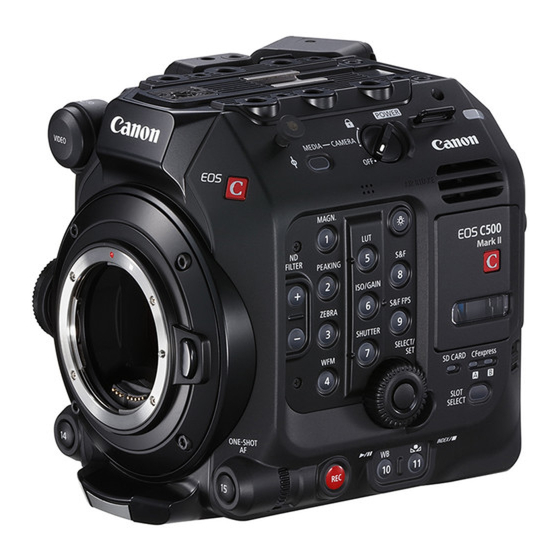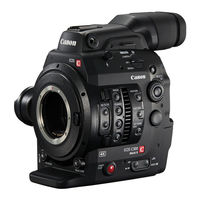
Canon EOS C300 Mark III Manuals
Manuals and User Guides for Canon EOS C300 Mark III. We have 3 Canon EOS C300 Mark III manuals available for free PDF download: Instruction Manual, Manual
Canon EOS C300 Mark III Instruction Manual (260 pages)
Digital Cinema Camera
Brand: Canon
|
Category: Digital Camera
|
Size: 24.3 MB
Table of Contents
-
Camera12
-
Handle Unit21
-
Preparations25
-
Recording51
-
ND Filter73
-
Aperture74
-
Focus81
-
Manual Focus82
-
One-Shot AF86
-
Zoom92
-
Recording Audio102
-
Color Bars110
-
Video Scopes111
-
Using Metadata114
-
Pre-Recording119
-
Customization125
-
Look Files132
-
Playback139
-
User Luts159
-
Audio Output161
-
Using Networks164
Advertisement
Canon EOS C300 Mark III Manual (254 pages)
Digital cinema camera
Brand: Canon
|
Category: Digital Camera
|
Size: 21.54 MB
Table of Contents
-
Camera12
-
Handle Unit21
-
Preparations25
-
Recording51
-
ND Filter72
-
Aperture73
-
Focus80
-
Manual Focus81
-
One-Shot AF84
-
Zoom90
-
Recording Audio100
-
Color Bars108
-
Video Scopes109
-
Using Metadata112
-
Pre-Recording118
-
Customization123
-
Look Files129
-
Playback137
-
User Luts157
-
Audio Output159
-
Using Networks162
Canon EOS C300 Mark III Instruction Manual (247 pages)
Digital Cinema Camera
Brand: Canon
|
Category: Digital Camera
|
Size: 21.89 MB
Table of Contents
-
Camera12
-
Handle Unit21
-
Preparations25
-
Recording51
-
ND Filter72
-
Aperture73
-
Focus80
-
Manual Focus81
-
One-Shot AF84
-
Zoom90
-
Recording Audio100
-
Color Bars108
-
Video Scopes109
-
Using Metadata112
-
Pre-Recording118
-
Customization121
-
Playback133
-
User Luts151
-
Audio Output153
-
Using Networks156
Advertisement
Advertisement


